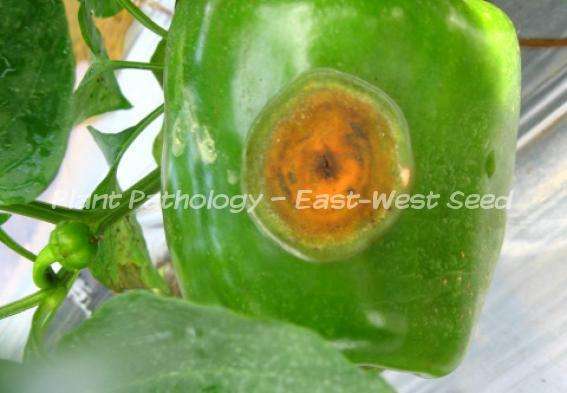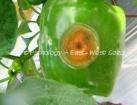Causal Agent:
Fungus (Colletotrichum spp.)
| Characteristic Symptoms: | |
 |
Fruit lesions are circular and sunken spots with mass of orange or peach-colored spores (C. gloeosporioides, C. acutatum) or concentric rings of black acervuli (C. capsici). |
 |
Fruits may be infected at the early stage but symptoms are expressed at maturity when conditions are favorable for infection. |
| Conditions for Disease Development: | |
 |
The pathogen is soil-borne and overwinters on plant debris from infected crops and in other plant species |
 |
Spores produced on foliage can be carried through rain splashes to the developing green fruit.
|
 |
Although symptoms do not appear until the fruit is ripening, the infection actually occurs when fruits are small and green.
|
 |
Diseased fruit, foliage and stems are source of secondary inoculum, which spreads from plant to plant in the field.
|
 |
The disease is favoured by moderate temperature (20-24°C) and frequent rainfall.
|
| Management and Control: | |
 |
Use pathogen-free seed. |
 |
Remove and destroy infected plants/fruits as soon as symptoms are observed to minimize spread of disease.
|
 |
Avoid overhead irrigation or prolonged moisture to minimize disease severity. |
 |
Staking increases air movement and may help reduce infection in the field.
|
 |
Crop rotation for 2-3 years may help reduce inoculum in the soil.
|
 |
Harvest fruit before it fully ripens.
|
 |
Apply copper-based fungicides (e.g. Cupravit®, Super BlueⓇ, Vitigran blueⓇ, FunguranⓇ, KocideⓇ, Hydroxide superⓇ) at early fruit set when conditions are favorable. |
 |
Application of other fungicides like difenoconazole (e.g. ScoreⓇ, MontanaⓇ, PursueⓇ, BashⓇ), difenoconazole+proficonazole (e.g. ArmureⓇ), Pyraclostrobin (e.g. Cabrio 25 ECⓇ), Bacillus subtilis strain QST 713 (e.g. Serenade®, Virtuoso®) and azoxystrobin (Amistar®, MiradorⓇ, RobatoⓇ). |
| References: | |
| AVRDC Factsheet. AVRDC Publication 04-574 (2004) at www.avrdc.org; Compendium of Pepper Diseases (2003) by APS | |
To view other diseases, click here.
Need more help? Ask the Doctor.






